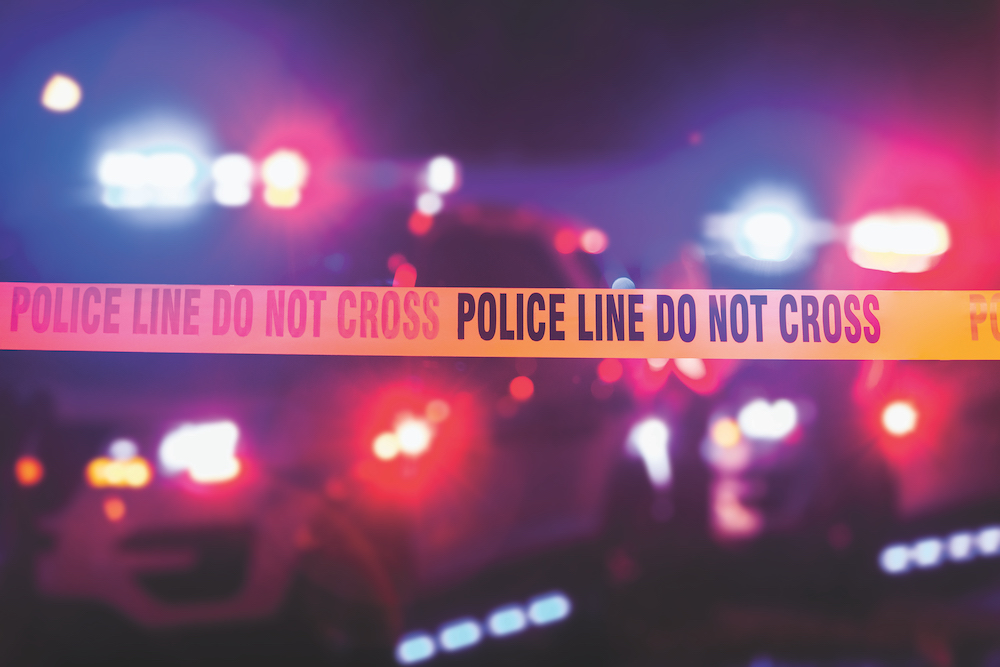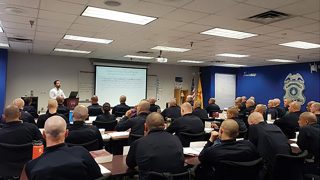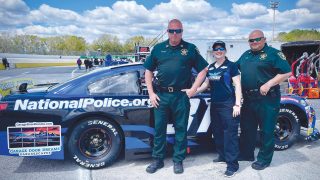
As the public discourse around behavioral health has grown — one in six American adults are living with a mental health condition, after all — law enforcement organizations around the country have adapted.
Whether it’s a behavioral health unit in Portland, Oregon, a joint mental health evaluation team between the Burbank Police Department and the Los Angeles County Department of Mental Health, or a round-the-clock staff of mental health and threat assessment experts in Palm Beach, Florida, agencies across the United States are sending a message.
Understanding mental health is the first step in policing those who are struggling with it. Not all of this is done altruistically, of course. One in 10 calls fielded by police involve a person who has a mental illness,1 and there are 10 times more individuals who have a mental illness in prison than there are in state mental hospitals.2
Then there are the high-profile incidents that fill our news cycles far too often. In 2017, one in four people killed by police were battling mental health issues.3 Overall, people who are living with a mental illness are 16 times more likely to die as a result of a law enforcement encounter than the general population.4
There’s a lot being done to address the way police officers handle situations that involve the mental health of civilians. Unfortunately, that same diligence isn’t quite there when it comes to helping law enforcement officers themselves — particularly those who routinely face the most stressful interactions.
The science behind trauma in law enforcement personnel
More and more research suggests that the on-the-job stress police and other first responders face during the course of their duties makes them especially vulnerable to mental health concerns such as substance use, depression, post-traumatic stress injury (PTSI), and suicide — often at much higher rates than the general public.
Estimates suggest that at any given time, an average of 15% of police officers in the United States experience symptoms of PTSI.5 Commonly known as post-traumatic stress disorder, and defined as such in the Diagnostic and Statistical Manual of Mental Disorders (DSM-5), post-traumatic stress alters the neural pathways in the brain as the result of an exposure to trauma. Going a step further, suicide is so prevalent in the law enforcement profession that the number of police officers who died by suicide in 2018 is more than triple that of those who were killed in the line of duty.6
Obvious factors are at play here — consistent professional stress and easy access to firearms, to name a couple — but a lot of the concern behind these numbers lies in the science of the nervous system.
When a person encounters a high-stress situation, one part of the brain (the amygdala) sends a distress signal to a different part of the brain (the hypothalamus). The hypothalamus acts as a command center, communicating with the rest of the body through the autonomic nervous system, which controls involuntary functions like heartbeat, breathing and blood pressure. The amygdala’s distress signal prompts the hypothalamus to send signals to the adrenal glands, which respond by pumping adrenaline (or epinephrine) into the bloodstream. This jolt provides energy to all parts of the body while a person’s pulse, blood pressure and heartbeat rise rapidly.
There are two components to the body’s autonomic nervous system: the sympathetic, which acts like the gas pedal on a car, and the parasympathetic, which functions like a brake. The sympathetic nervous system triggers the body’s “fight-or-flight” response, providing a burst of energy so that the body can react to dangerous situations. The parasympathetic nervous system calms the body down after that perceived threat has passed.
These changes happen so fast that people don’t know they’re occurring. It’s why a person can jump out of the way of a baseball, bicycle or car that’s headed in their direction before the brain’s visual center can even fully process what’s happening.
But that’s just the beginning. If the brain continues to perceive danger, the hypothalamus activates the second component of the stress response system, which is known as the HPA axis — the hypothalamus, the pituitary gland and the adrenal glands.
The HPA axis relies on a series of hormonal signals to keep the sympathetic nervous system activated. If danger is in the air, a series of hormones travels to the adrenal glands to release cortisol, which helps the body stay on high alert. Cortisol levels dissipate once threats pass, and the parasympathetic nervous system again puts on the brakes.
That startling synopsis is what plays out in the brain of any regular person who’s driving through an intersection before spotting a car blowing a stop sign out of the corner of their eye. It’s a near miss, and an incident that (hopefully) doesn’t happen more than once in a blue moon, but it has a lasting effect on the psyche.
For some, those near misses happen much more routinely. For some, the experience of trauma — mind-twisting, life-altering distress — is a routine part of their job.
The effects of trauma on specialty law enforcement officers
School shootings have become far too commonplace in the United States since the massacre at Columbine High School in 1999. On that horrifying April day, two seniors murdered 12 classmates and a teacher before turning the guns on themselves in what was, at the time, the deadliest school shooting in U.S. history.
The students who survived, those who had assumed they were just walking into a safe space on an otherwise ordinary day, would be forever changed. So would the SWAT team members who stepped inside Columbine to help — even if they’re still discovering exactly how their lives have been altered.
The Jefferson County Regional SWAT team, the unit of first responders dispatched to Columbine as the shootings took place, had 10 members when they arrived at the Littleton, Colorado, high school on April 20, 1999. By 2002, seven of those 10 had either left the department or been reassigned.7
“It was just beyond anything I’d ever thought I’d see in my career,” SWAT team member Grant Whitus told the Associated Press in an April 2019 story. “So many children were dead.”
After the attack, SWAT team members went through a group debriefing and were offered department-paid therapy. But no one participated in the therapy sessions due to the stigma attached.
Whitus stayed on, and the Jefferson County SWAT team had 12 members by the time another school shooting happened in a Denver suburb in 2006. Over the next three years, eight people left, including Whitus and Al Joyce, the latter of whom divorced his wife, withdrew from the world and wound up homeless by 2013.
That’s what post-traumatic stress is — an injury. Building resilience is the best preventative medicine there is.
Such departures — and department turmoil — became the norm after events with mass casualties. Six members of the Broward County SWAT team left within a year of the February 2018 shooting at Florida’s Marjory Stoneman Douglas High School that left 17 dead. An officer at the Newton Police Department in Connecticut was awarded $380,000 after an arbiter agreed that the department lacked proper procedures for dealing with PTSI associated with first responders from the 2012 Sandy Hook Elementary School shooting.8
The stigma of mental illness has begun to subside in the public at large in the two decades since Columbine, but for specialized law enforcement officers, opening up about PTSI can still feel like a sign of weakness.
Yale University psychiatrist Jill Barron, who worked with first responders after both 9/11 and the Sandy Hook shootings, told The Washington Post that while broken bones are considered battle wounds, the hero culture of the front lines does not allow for mental injuries to be even an acknowledgement, let alone a hurdle.
In a 2017 survey of first responders, almost 40% said they would face negative consequences at work for seeking mental health services.9 “They’re dealing with trauma after trauma after trauma while being told to suck it up, toughen up,” Barron said. “The attitude is push it down and move on.” That’s a pattern that cannot continue.
What’s already being done
A 2015 survey of more than 4,000 paramedics, emergency medical technicians, firefighters and police officers revealed that emergency workers are 10 times more likely to attempt suicide on average than any other person, and approximately 6% of those polled had tried to take their lives.10
The list of states that have passed legislation to provide workers’ compensation for first responders who are suffering from PTSI is growing, and it includes Colorado, Texas, Connecticut, Vermont, Minnesota and Louisiana. But challenges remain. A bill passed in Connecticut in 2019 offers benefits for police officers, firefighters and parole officers but doesn’t cover EMTs, paramedics and dispatchers. It also requires a documented mental health professional’s diagnosis of a qualifying event, making trauma a somewhat subjective matter.
The seeds of change have begun to be planted. The U.S. Bureau of Justice Assistance has rolled out a pilot program to provide resilience training for law enforcement officers that is designed to give participants the skills to manage the heavy loads of stress they face.11 New Jersey unveiled a similar statewide program that intends to provide officers with special training on how to handle trauma that is common in their line of work.12 Other agencies have provided their law enforcement personnel with confidential peer counseling services.
while admirable, is only a half-measure. Without officer-to-officer transparency in the face of the mental health concerns tactical law enforcement all over the country routinely deal with, progress will stall. Recovering in anonymity can be as isolating as suffering in silence.
Where we can improve
What must be addressed is the development of resilience long before traumatic incidents occur. Far too often, specialty law enforcement officers turn to alcohol or other substances to help them decompress after particularly stressful experiences. Part of the job description of specialty law enforcement officers is to be able to emotionally detach in order to make the right decision in a crisis. That’s not going to change, but the preparation for the ensuing mental fallout must.
Repeated exposure to trauma changes neural pathways in the brain, and for tactical law enforcement officers who frequently experience volatile events, their minds and bodies are especially susceptible to injury.
And that’s what post-traumatic stress is — an injury. What we must do is make sure that the first time a SWAT team or SVU member seeks help for PTSI or trauma is not when they experience a crisis. Building resilience is critical. It’s the best preventative medicine there is.
How can we get there? Here are some realistic, reasonable ways to start.
Reduce the stigma: The biggest and perhaps most essential reason why long-term stress and PTSI manifest? Law enforcement, particularly in high-specialty units, is a hypermasculine culture where burying both physical and mental problems is an unwritten mandate. By setting up formal peer-to-peer counseling groups along with offering access to professional counselors, tactical law enforcement officers will be able to regularly communicate about the stressors of their work, in an appropriate setting, with those who know it best: their colleagues.
Promote self-care: If the goal of any activity is “to take my mind off of it,” that’s just an excuse to bury short-term stress that will continue to manifest over the long haul. Taking a long nap after a traumatic incident at work or going to the bar for a few drinks to forget about it all are not healthy methods of coping. Meditation, exercise, deep breathing, healthy diets and strict sleep schedules are all ways to balance cortisol levels and positively focus elsewhere, allowing for the development of naturally healthy habits for managing stress when it does come.
Provide education: Having real-life examples of what not to do is often highly effective. The CDC’s 2013 “Tips from Former Smokers” national advertising campaign, which featured raw, disturbing visuals of the long-term effects of cigarettes on smokers, spurred more than 100,000 Americans to successfully quit smoking.13 Whether through statistics, anecdotes or — most likely — testimonials from fellow tactical officers who have struggled with PTSI, live proof of the dangers of not seeking help is often the most likely tactic to drive action.
Embrace a work–life balance: During and immediately after crisis situations, tactical law enforcement officers often work many consecutive days without a break. While this may be unavoidable in certain circumstances, schedules should be proactively managed. Ensure that officers are taking a requisite amount of time off each quarter. Offer department family days, cook-offs or take-your-child-to-work days. Promote a culture that embraces family life and outside interests so that officers are working to live rather than living to work.
PTSI can take years to manifest. Even for those nearing or in retirement, there can be adverse effects from trauma that happened decades ago. Sights, sounds and smells can produce flashbacks to dark moments in the past that were forgotten but that never really left.
Specialty law enforcement is, at its core, a high-stress field. It takes a certain mentality to willingly sign up for the dangers and potential dread that accompany such a position. But no officer should ever feel alone. By building resilience from the ground up, we can help guide any high-intensity law enforcement professional toward post-traumatic growth rather than a spiral toward uncertainty, isolation and despair.
Keeping civilians safe is the primary objective of any high-risk operations team. The officers providing that protection deserve to feel like we’ve got their backs, too.
This article originally appeared in the Winter 2020 edition of The Tactical Edge, the official publication of the National Tactical Officers Association, and is reprinted with permission.
REFERENCES:
- “When Cop Calls Involve the Mentally Ill, Training Is Key.” All Things Considered, NPR. 14 June 2014. npr.org.
- Al-Rousan, Talia, et al. “Inside the Nation’s Largest Mental Health Institution: A Prevalence Study in a State Prison System.” BMC Public Health. 20 April 2017. ncbi.nlm.nih.gov/pmc/articles/PMC5397789.
- Hoffman, Erica. “Police Need More Mental Health Training.” Mental Health First Aid, The Hill. 22 Feb. 2018. mentalhealthfirstaid.org.
- “Learn About Our Key Issues.” Treatment Advocacy Center. treatmentadvocacycenter.org.
- Violanti, John. “PTSD Among Police Officers: Impact on Critical Decision Making.” Community Policing Dispatch, U.S. Department of Justice, vol. 11, no. 5. May 2018. cops.usdoj.gov.
- Hilliard, Jena. “New Study Shows Police at Highest Risk for Suicide of Any Profession.” Addiction Center. 14 Sept. 2019. addictioncenter.com.
- Banda, P. Solomon. “School Shootings Draw Attention to Officers’ Mental Health.” Associated Press. 17 April 2019. apnews.com.
- Ebersole, Rene. “First Responders Struggle with PTSD Caused by the Emergencies, Deaths, Tragedies They Face Every Day.” Washington Post. 26 Oct. 2019. washingtonpost.com.
- “Majority of First Responders Face Mental Health Challenges in the Workplace.” University of Phoenix. 18 April 2017. phoenix.edu.
- Barber, Erich, et al. “Survey Reveals Alarming Rates of EMS Provider Stress and Thoughts of Suicide.” Journal of Emergency Medical Services, vol. 40, no. 10. 28 Sept. 2015. jems.com.
- “Valor Initiative Pilot Puts Character at the Heart of New Resilience Training for Law Enforcement.” Bureau of Justice Assistance, U.S. Department of Justice. 9 May 2019. bja.gov/successstory.
- Stainton, Lilo H. “NJ Launches Nation’s First Stress ‘Resiliency’ Program for Police Officers.” NJ Spotlight. 7 Aug. 2019. njspotlight.com.
- McAfee, Tim, et al. “Effect of the First Federally Funded US Antismoking National Media Campaign.” The Lancet, vol. 382, no. 9909, 9 Sept. 2013, pp. 2003-2011. thelancet.com/journals.
As seen in the September 2020 issue of American Police Beat magazine.
Don’t miss out on another issue today! Click below:





